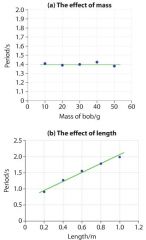![]()
![]()
![]()
Use LEFT and RIGHT arrow keys to navigate between flashcards;
Use UP and DOWN arrow keys to flip the card;
H to show hint;
A reads text to speech;
17 Cards in this Set
- Front
- Back
|
What is a pendulum? |
A simple pendulum consists of a weight, called a bob, swinging on a string. A pendulum is a simple machine for transferring gravitational potential energy to kinetic energy, and back again. |
|
|
What three things can be used to describe how a pendulum swings? |
Amplitude - how far from the vertical the string moves. Time period - the time taken for one complete swing. Frequency - the number of complete swings per second. |
|
|
What equation links the time period and frequency? |
T = 1 ÷f T = time period in seconds, s f = frequency in Hertz, Hz |
|
|
A pendulum has a frequency of 2.0 Hz. Calculate the time period for one swing of the pendulum. |
Time period= 1 ÷ frequency = 1 ÷ 2.0 = 0.5 s |
|

Look at the results of a pendulum investigation. What do they show about the factors affecting the time period? |
Figure (a) shows that the period of the pendulum does not depend on the mass of the bob. Figure (b) shows that the period of the pendulum does depend on the length of the string. The time period of one swing of a pendulum is dependent only upon the length of the pendulum and not upon the mass of the bob, or how high it swings. Longer pendulums have greater time periods than shorter pendulums. |
|
|
The pendulum shows the principal of conservation of energy in action. Gravitational potential energy is converted to kinetic energy and back, over and over again, as the pendulum swings. Describe the energy transfers while the pendulum is swinging. |
When the pendulum bob is at the start of its swing it has no kinetic energy because it is not moving, but its gravitational potential energy (GPE) is at a maximum, because it is at the highest point. As the bob swings downwards it loses height. So its gravitational potential energy (GPE) decreases. The work done on the bob by the gravitational force (weight) pulling it downwards increases its kinetic energy. The loss of GPE = the gain in KE. At the bottom of its swing, the bob’s kinetic energy is at a maximum and its gravitational potential energy is at a minimum - because it is at its lowest point. As the bob swings upwards it slows down. Its kinetic energy decreases as work is done against its weight. As it gains height the gravitational potential energy increases again. At the very top of its swing it stops for a moment. It once again has no kinetic energy, but its gravitational potential energy is at a maximum. |
|
|
Does the total (GPE + KE) change during the swing? |
At all points during the swing, the total (GPE + KE) is constant.
In a real pendulum the bob’s swing will become slightly lower with each swing, because some energy is lost (dissipated, ‘wasted’) through heating, due to air resistance. |
|
|
A pendulum consists of a light string of length 1.2 m and a bob of mass 0.02 kg. At its highest point the bob is a vertical distance of 80 mm higher than the lowest point of its swing. State the form of energy that the bob has at: (a) the lowest point of its swing (b) the highest point of its swing |
(a) At the lowest point of its swing the bob has kinetic energy. (b) At the highest point of its swing the bob has potential energy. |
|
|
A pendulum consists of a light string of length 1.2 m and a bob of mass 0.02 kg.
At its highest point the bob is a vertical distance of 80 mm higher than the lowest point of its swing. Calculate the maximum speed of the pendulum bob. |
As the bob swings from its highest to its lowest point potential energy is converted to kinetic energy. m = 0.02 kg g = 9.8 ms^-2 h = 80 mm = 0.08 m Ek = ½mv^2 = mgh = Ep ½ × 0.02 × v^2 = 0.02 × 9.8 × 0.08 v^2 = 1.568 v = 1.2522 = 1.3 ms^-1 Maximum speed of bob = 1.3 ms^-1 |
|
|
What is the period of a pendulum? |
The length of time taken for one complete swing. |
|
|
A pendulum has a frequency of 0.01 Hz. What is its period? |
T = 1 ÷ f = 1 ÷ 0.01 Hz = 100 s. |
|
|
A pendulum has a period of 15 seconds. What is its frequency? |
f = 1 ÷ T = 1 ÷ 15 s = 0.067 Hz. |
|

Look at the photo of the girl on a swing. This pendulum is swinging with a large amplitude. How would the period of the swing change if a heavier child was using it? |
It would not change, as the mass of the bob does not affect the period. |
|
|
If you were investigating the effect of mass on the time period of a pendulum, why would you use five different masses instead of just two? |
If only two masses were investigated, and inaccuracies in the measurements gave two different results, it might appear that the period changed with mass. Using five results allows a line of best fit to be plotted, which helps to remove the effects of any inaccuracies in the measurements. |
|
|
A student is timing the swings of a pendulum using a stopwatch. She times 10 swings at a time, and then divides this time by 10. Why is this more accurate than timing individual swings? Explain why the student should repeat the measurement several times for each pendulum tested. |
The accuracy of the timing will be limited by the reaction time of the observer, and the difficulty in judging exactly when one swing is completed. The size of this type of error is likely to be the same whether one swing or 10 is measured. Therefore measuring 10 swings and then dividing the time by 10 will ‘split’ the error between each swing, providing a more accurate result for the time for a single swing. Even with the method described, there will still be some experimental error in the timing. Repeating the timing exercise will allow the student to gauge the repeatability of the investigation. |
|
|
If you stand up on a swing instead of sitting on it, you change the period. Suggest how and why the period changes. |
The period of a simple pendulum depends only on the length of the pendulum. The length is the distance between the point of suspension and the bob. The weight of the bob will act from its centre of mass. If you stand up on a swing, you raise your centre of mass; this brings the centre of mass closer to the point of suspension and effectively shortens the pendulum. A shorter pendulum will have a shorter period. |
|
|
What are the key points to remember? |
A pendulum consists of a bob on a string.
The period of a pendulum is the time for one complete swing. time period = 1÷frequency ...... T = 1 ÷ f The period of a pendulum depends only on its length – the longer the pendulum, the longer the period. |

